The terms Japanese martial arts refer to a wide variety of martial arts originating in Japan. They translate at least three commonly used Japanese terms interchangeably: budō, whose literal meaning is "way of war," bujutsu (武術, "techniques of war"), and bugei (武芸, "martial art").
The first term, budō, is a modern term, and refers to the practice of martial arts as a way of life, including both physical, moral and spiritual dimensions. The terms bujutsu and bugei have more restricted definitions, at least in their proper historical usage.
Bujutsu refers specifically to the practical application of martial techniques to real-life combat situations, while bugei refers to the adaptation of these techniques and tactics for teaching in a specific setting.
Japanese Martial Arts History
In Japanese, Koryū (古流, literally "Ancient School") refers to Japanese martial arts schools that predate, in terms of their founding, the Meiji Restoration (1866) or the Haitōrei Edict (1876), which prohibited the carrying of swords.
Japanese martial arts developed within koryu through the centuries until 1868. Samurai and ronin all studied, innovated, and transmitted within these institutions. There was a multitude of koryu where weapons and bare hand art were studied by bushi.
After 1868 and its social upheaval, the mode of transmission was modified, a change that explains the separation into two categories Koryu Bujutsu (martial arts of the ancient school) and Gendai budō (modern martial arts).
Today, these two forms of transmission coexist. For some years in Europe, one can find both Koryu Bujutsu and Gendai budō. Sometimes, in Japan as elsewhere, the same masters and the same students study both forms of martial arts, ancient and modern.
Koryu Bujutsu is often referred to as Bujutsu or even Kobudo.
Koryu Bujutsu
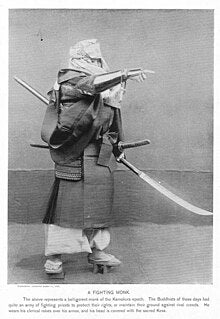
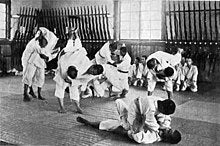
Hand to hand arts
Ju-jutsu
Ju-jutsu class in a rural school in Japan, 1922.
Ju-jutsu, or jūjutsu or jiu-jitsu (this term is used by mistake because of a wrong romanization) , gathers fighting techniques that were developed during the feudal era of Japan to defend oneself when one is unarmed.
These techniques are classified in three main categories: Atemi waza (striking technique); Nage waza (throwing technique) and Katame waza (control technique) in order to master one's opponent.
Until the 17th century, the teaching of ju-jutsu went hand in hand with that of armed combat (kenjutsu, bojutsu) as part of samurai training. During the Edo period, they began to be taught separately, until they formed a vast body of 725 officially recognized styles and more than 2,000 schools.
With the Meiji Restoration, the ancient fighting arts lost consideration and were banned. At the beginning of the 20th century, the techniques of some schools of ju-jitsu were taken up and adapted for use in judo and aikido.
Today, the term ju-jitsu encompasses a wide variety of practices ranging from sports forms similar to judo to forms oriented towards self-defense. Their common characteristic is to combine the teaching of striking techniques, throwing techniques and immobilization techniques.
Taijutsu
Taijutsu (体術) also found as Taijitsu, Tai-jitsu or Tai Jitsu, etc., is an original Japanese martial art. It is an ancient generic name for empty-handed fighting methods, sometimes known as Koshi no Mawari and from which the concept of Jūjutsu (flexibility technique) emerged. In the past, Taijutsu, like Jūjutsu, was often associated with and/or derived from Yawara.
Various names were used during the different historical periods of Japan and changed according to the geographical regions and the different successors. Each of these names referred to slight differences in technical characteristics where the whole body or part of the body was used.
The earliest references to these unarmed combat arts can be found in the early historical records of Japan called the Kojiki (Chronicle of Ancient Facts) and the Nihon Shoki (Chronicles of Japan), which concern the mythological creation of the country and the establishment of the imperial family.
Taijutsu is a very ancient fighting art. Identified as a variation of Kumiuchi, it is recognized as the precursor of other Japanese martial arts. Its origin is not precisely known, but it was rediscovered and codified around the seventeenth century by a warrior named Nagao Kenmotsu, a Samurai of the Ittō-ryū (一刀流) and Yagyū Shinkage-ryū (柳生新陰流) schools.
Two main currents of Taijutsu currently exist: modern European French Taijitsu (or Nihon Taijitsu) (by Roland Hernaez and Daniel Dubois) and traditional Japanese Taijutsu (or Nihon Taijutsu) stemming from the Koryū Bujutsu named above and including Ninpō Taijutsu or Budō Taijutsu.
The techniques fall mainly into two main groups:
- Dakentaijutsu: techniques based on blocks (Uke waza) and strikes (Atemi waza) on the vital points of the human body, bony (Koppōjutsu), muscular (Koshijutsu) or internal/nervous (Kyusho). (Note: The techniques used in Dakentaijutsu have a very large number of similarities with those used in Kenpō).
- Jūtaijutsu: techniques of throws (Nage waza), grabs, locks and dislocations (Katame waza). (Note: The techniques used in Jūtaijutsu have a very large number of similarities with those used in Jūjutsu.)
- Taihenjutsu: techniques based on movements (Sabaki waza), rolls and/or falls (Ukemi waza), escapes (Inton waza), postures, etc.(Note: Taijutsu as well as Jūjutsu, are two names currently being used interchangeably to cover generic unarmed combat systems).
Sumo
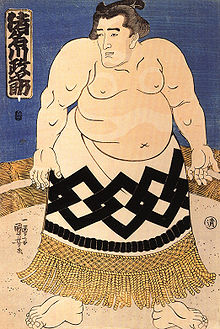
Sumō (相撲), often considered Japan's national sport, is probably one of the oldest Japanese martial arts. The country's earliest written records, which date from approximately the seventh century, place the first sumo fight in 23 B.C. This fight is said to have taken place at the request of the Emperor, and only stopped when his injuries forced one of the fighters to stop.
Beginning in 728, Emperor Shōmu (聖武 天皇, 701-756) instituted official fights during harvest festivals. The tradition of fighting in the presence of the Emperor continued, but also extended to holding them at Shinto festivals, and sumo training was eventually incorporated into military training.
By the end of the seventeenth century, sumo was an organized professional sport open to the public and popular with both the working classes and the powerful.
In the early 21st century, sumo retains much of its traditional framework, with the referee dressed as a Shinto priest, and a ritual purification of the arena.
Victory in a fight is achieved through codified wrestling techniques, the goal being to force the opponent to touch the ground with any part of the body other than his feet, or to touch the ground outside the confines of the arena. Six major tournaments are held annually in Japan, where sumotori still enjoy great prestige.
Ninjutsu
Ninjutsu (忍術), sometimes synonymous with ninpō (忍法), is the martial art and warfare tactics of the ninjas, warrior-spies of feudal Japan (11th to 16th centuries). Nowadays, many modern martial styles claim to be ninjutsu, although the historicity of their teaching and lineage is controversial. This "modern ninjutsu" is often influenced by the Bujinkan school, founded in the 1970s.
Japanese Martial Arts in Weapon
Battōjutsu
Batto-jutsu means "art of drawing the sword." It is a Japanese martial art that involves drawing and cutting at the same time with a sword. This art belongs to the Kenjutsu group. Appearing around the 16th century, it is categorized in the Koryu but 2 recent forms (Toyama-ryū and Nakamura-ryū, based among others on Battojutsu) are considered in the Gendai budō.
Techniques: study of basic cutting techniques, study of combat guards, realistic positions (not kneeling), cutting practice and real sword training on targets (bamboo).
Bō-jutsu
A discipline of Japanese origin, bō-jutsu is the martial art of long stick (Bō) wielding as opposed to Jō-jutsu, which is the short stick technique. Bō-Jutsu is studied separately or as a complement to the empty-handed disciplines Karate, Aikido, or Judo or as an integral part of a kobudo or kendō weapon system.
The handling of the Bō is similar to that of the long stick used in medieval Europe by peasants. In Japan, it is practiced without special protection, but "free assaults" are generally absent. Training is based on learning Kata, codified combat sequences against one or more opponents, first alone, then with partners.
Jō-jutsu
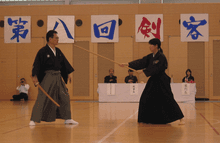
Jō-jutsu, an ancient Japanese martial art, was invented by Muso Gonnosuke 400 years ago.It uses the jō, a straight stick 1.28 meters long and 2.5 cm in diameter. Jōdō (杖道 Way of the Short Stick) is derived from Jō-jutsu.
Hojōjutsu
Hojōjutsu (捕縄術) also known as nawajutsu (縄術) is the traditional Japanese martial art of tying a person up with ropes. For mistress Benio, a rope artist quoted in The Erotic Imagination in Japan, "The rope in Japan is a strong symbol, synonymous with the annihilation of the individual.
Often, in historical films, the expression onawa ni naru (to become of a rope) is used: it means that if you commit a bad deed, you will end up tied with a rope." Hojōjutsu is typically a product of Japanese culture regardless of the material, technique, or method employed depending on the teaching in specialized schools.
As a martial art, hojōjutsu is rarely if ever the product of self-study but rather is taught in martial arts schools (budō) as an advanced complement to ju-jitsu. Regardless of their origin, hojōjutsu techniques and methods are rarely disclosed outside of Japan.
For this reason and unlike its cousin, Japanese sexual bondage (Shibari), it is less well known despite the Internet. Many consider it a dying art.
Iaijutsu and Iaido
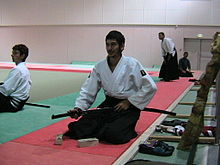
Iai-jutsu (the technique of drawing by cutting) is the classical art behind the more modern Iaido. Iaidō (居合道?) is a martial art of Japanese origin focusing on the act of drawing the sword and slashing in one movement. Just like other budō, this martial art focuses more on the harmony of the movements and the spiritual approach (Zen influence), than on the technical efficiency. In recent years, Japanese sensei have been advocating a more offensive approach, directed towards a "combat" iaidō, closer to iaijutsu.
Kenjutsu
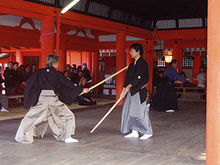
Kenjutsu of the Hyoho Niten Ichi Ryu at Itsukushima Jinja, bokken kata
Kenjutsu (剣術, literally "sword technique", i.e. fencing) is an ancient Japanese martial art (bujutsu), which focuses on the mastery of katana and wakizashi swords.
It was taught to samurai and was part of the bujutsu of feudal Japan. We practice kenjutsu without protections. If the purpose is the handling of the katana, training with two is done with a bokken; training in drawing (iai) is done with an iaito.
Kyūjutsu
Naginatajutsu
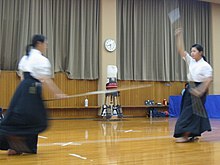
Naginatajutsu (長刀術 / 薙刀術) is a Japanese martial art. It studies the handling of the naginata, a kind of traditional halberd. Originally, Naginata was one of the most dangerous melee weapons used by generals as well as soldier-monks (sohei).
Nevertheless, later on, its handling was mainly taught to women (so that a samurai's wife could defend the household when her husband was away, because besides bandits, looting and selling captured losers into slavery were widely practiced). That's why nowadays in Japan, naginatajutsu is more practiced by women than men.
Ninjutsu
Ninjutsu (忍術), sometimes synonymous with ninpō (忍法), is the martial art and warfare tactics of the ninjas, spy warriors of feudal Japan (11th to 16th century). Nowadays, many modern martial styles claim to be ninjutsu, although the historicity of their teaching and lineage is controversial. This "modern ninjutsu" is often influenced by the Bujinkan school, founded in the 1970s.
Shurikenjutsu
Shurikenjutsu is a martial art that uses shuriken, an arsenal of spikes and throwing stars, the latter also known as "Chinese stars", small throwing weapons.
Sojutsu
Sōjutsu (槍術) is a Japanese yari or (spear) handling technique. This martial art is practiced clad in the ancient armor of the samurai.
Gendai budō
The term Gendai budō refers to current martial arts. Current martial arts are more commonly referred to as budō.
Shin Budo emphasizes the study of the mind. This in no way means that this pursuit is less in other Budos but that the public or pedagogical presentation places it later in the practitioner's life. We have classified Aikibudo in the Japanese martial arts because it is simply immersed in this cultural universe by the way of moving, acting and feeling.
Shin Budo
Aikibudo
Aikibudō is a traditional martial art of Japanese origin (budō) essentially based on defense techniques. It is very close to aikidō, and inherits the same teachings from the martial practices of the samurai. It corresponds to a preliminary form of aikidō, taught by its founder, Morihei Ueshiba, before the war.
Aikido
Aikido is composed of techniques with weapons and bare hands using the strength of the opponent, or rather his aggressiveness and his will to harm. These techniques are not intended to defeat the opponent, but to reduce his attempt at aggression to nothing.
Therefore, unlike Aikibudo, aikido includes a dimension of way (道, do) in which the technique is the support of a spiritual search which in turn feeds the gestures.
For its founder Morihei Ueshiba, aikido is therefore incompatible with the idea of competition, is not a sport but a method with an objective of peace between men.
Kyudo
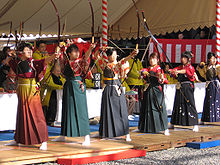
Kyūdō (弓道, literally "the way of the bow") is a Japanese martial art (budō), derived from warrior archery (kyūjutsu). This discipline is distinguished from its Western counterpart by the mixed influences specific to Japanese culture: Zen, Confucianism and also Taoism and Shintoism.
Kyūdō is one of the Japanese martial ways, seeking the development of body and group discipline, through the mastery of gestures. The practitioner seeks a perfect movement, to be able to transcend both the desire of the ego and the very earthly objective, consisting of piercing a sheet of paper serving as a target, with a minimum of muscular tension and a maximum of spiritual energy, ki.
The aesthetic gesture is the result of a codified choreography. Accurately hitting the target is the result of a good balance between a disciplined and harmonized body and mind.
Shorinji Kempo
Shorinji Kempo is a Japanese martial art founded in 1947 by Kaîso (founder) So Doshin, the result of a combination of different Chinese and Japanese martial art schools. It is both a traditional martial art and an effective self-defense system. The practice of Shorinji Kempo includes multiple aspects: Goho (techniques called "hard": punches, kicks), Juho (techniques called soft (releases, projections or immobilizations on seizures) as well as Seiho, Chinkon, Embu, Randori.
Shorinji Kempo is not only a physical work, it includes a philosophical aspect in the practice through several principles. One of these fundamental principles is the importance of working in pairs (Kumite shutai). Partners become aware of the need for each other to progress, and develop a sense of mutual support and friendship.
Zen meditation (Chinkon) is an integral part of Shorinji Kempo.
Yoseikan Budo
Yoseikan Budo (養正館武道, Yōseikan budō) is a martial art developed in the late 1960s and officially founded in 1975 by Master Hiroo Mochizuki born in 1936 in Shizuoka (Japan), son of Master Minoru Mochizuki to whom he owes most of his knowledge.
This original method highlights the common logic between the different techniques of combat with bare hands or with weapons: this common thread called "undulatory movement". The power of the whole body is solicited and then transmitted to a limb or an extremity, by a wave movement.
This allows to optimize the power and the efficiency of any movement. The technical and pedagogical repertoire being in perpetual evolution and improvement, the possibilities are almost infinite.
The only limits are: the creativity of the teacher and the respect of the physical integrity of the students. The students wear a navy blue double-breasted jacket and white pants with a blue stripe. The students, from the beginner to the creator of the discipline, all wear the same white and blue belt, representing the union of Yin and Yang and symbolizing the wave principle.
Japanese Martial Arts Body to body
Judo
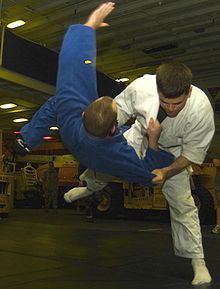
Judo (柔道, jūdō, literally way of suppleness) is a martial art and combat sport of Japanese origin (budō), founded by Jigoro Kano in 1882. It consists mainly of throwing techniques, ground control, chokes and locks. Practitioners (judokas) wear a reinforced cotton suit called a judogi, often mistakenly called a kimono, which is the generic name for traditional Japanese clothing.
The judogi is generally white, but to facilitate the distinction between the fighters in the competitions, a judoka can have a blue judogi at all the levels of competitions (if the judoka does not have a blue judogi, the distinction will be done using red or white belt).
For competitions from the national level, one of the two judokas must wear a blue judogi. Judo is practiced barefoot on a tatami. Judo is an Olympic sport.
Karate-Dô
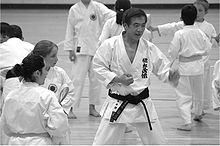
Karate lesson by Kanazawa sensei
Karate-Dô (空手道?) is said to be a Japanese martial art. However, the origin is Okinawan (the main island of the Ryūkyū archipelago, which was long an independent kingdom of Japan, south of the island of Kyūshū. In Japanese, the kanji (ideogram, literally Chinese writing) "kara" means emptiness, and more precisely emptiness in the Buddhist sense of the term, "te" is the technique and, by extension, the hand with which it is performed. So karate is literally translated as "the empty hand". One could also say, and think, "barehanded". However, karate was originally written with the kanji 唐手, which means "Chinese boxing" ("Tō-De", "the hand of China"). In 1935, because of the rise of Japanese nationalism, and also especially because of Sino-Japanese antagonism, to facilitate the recognition and the diffusion of karate, but also because he was a fervent follower of Zen Buddhism, Gichin Funakoshi (see below) replaced these kanjis by the current spelling, to "erase" the Chinese origin, thus sacrificing to the Japanese usage of the time.
Taihojutsu
Taihojutsu (逮捕術) is a synthesis of martial arts, created specifically for the needs of the Japanese police. Taihojutsu is the intervention method of the Japanese police and Kidotai (riot squad).
Taihojutsu combines the following disciplines in its synthesis: karate (wadō-ryū), judo (kodokan), aikido/aikijutsu (yoshinkan), nihon kenpō (kyōkai), nihon jujutsu (shinto yoshin-ryū), kendo/kenjutsu (Japanese fencing method), jōdō/jōjutsu (4-foot stick method), juken jutsu (bayonet method), keibo soho or keibo jutsu (police short stick method), boxing.
Taihojutsu was developed in the mid 1940s by the Tokyo Metropolitan Police Department. It was with the joint collaboration of the Japanese Police and several great martial arts masters that an attempt was made to determine a specific style that would be desirable for police officers.
The police administration of that time found itself in a new position, requiring its officers to coerce, subdue, and control a potential suspect, without having to harm him. This was in sharp contrast to the previous period in the middle of the last century, when such considerations had no reason to exist.
After the abolition of the feudal system in Japan in 1868, the samurai (feudal warrior) system no longer existed. Japan organized itself and created a new police force since the samurai caste was no longer there to ensure the function of maintaining order.
Japanese Martial Arts Weapon
Kendo
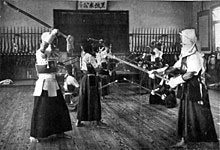
Kendo lesson in a rural school in Japan, c. 1922.
Kendo (剣道 / 劍道, kendō, literally the way of the sword) is the modern version of kenjutsu (剣術, kenjutsu, sword techniques), the sword fencing practiced in Japan in the past by the samurai.
By modern version, it should be understood that kendo is not only a martial art but also a competitive sport, now widely practiced in the world. However, Kendo is not just a set of sword fighting techniques and tactics. It also has a spiritual component. Kendo allows its practitioners to develop strength of character and determination.
Japanese Martial Arts Philosophies
Budō
Budo, Way of the Warrior, is both a practical Way and a philosophical orientation. Budo thus refers in part to the basic philosophy of the samurai, the one they followed from the beginning to the end of their era. It links the old martial arts as well as the new ones.
Each budō (in the first sense of Practical Way) is different. However, they are all globally derived from the same culture (even if there is some interbreeding, as in the case of karate), and they all have in common the search for martial efficiency; the same causes leading to the same effects, even if the forms vary.
Thus, there are concepts common to all budō. In their original form, budō are imbued with Zen Buddhism, Taoism, and Shintoism (traditional animistic religion).
Bushido
Bushido is a martial philosophy, a code of honor for Japanese samurai. It was established and codified towards the end of the 18th century.
Japanese Martial Arts Pedagogy
The Koryu use the Menkyo system, a kind of patent, as a certification or grade. The Menkyo is often referred to as the "honorable system" and is transmitted through a transmission degree, the Densho. The vast majority of these systems have five degrees of transmission with different names depending on the system. Gendai budō use the system of Dan, the higher degrees, and Kyu, the lower degrees, as well as the wearing of different colored belts for the awarding of grades.
Japanese Martial Arts Founders of historical schools
- Muso Gonnosuke : Shinto Muso Ryu
- Araki Mataemon: Shinkage-ryū
- Tsukahara Bokuden : Kashima Shintō ryū
- Gichin Funakoshi: Karate
- Shigeru Egami: Shotokai Karate-do
- Hōzōin In'ei : Hōzōin-ryū
- Iizasa Ienao : Tenshin Shōden Katori Shintō-ryū
- Ittosai Itō : Ittō-ryū
- Kamiizumi Nobutsuna : Shinkage-ryū
- Kano Jigoro: Judo
- Mikinosuke Kawaishi : Judo
- Katsuyuki Kondo : Daitōryū aikijūjutsu
- Kenwa Mabuni : Shito-ryu
- Chojun Miyagi : Goju-ryu
- Miyamoto Iori : Kenjutsu
- Miyamoto Musashi : Hyoho Niten Ichi Ryu
- Hiroo Mochizuki : Yoseikan Budo
- Minoru Mochizuki : Aikibudo (establishment in France), Judo
- Hironori Ohtsuka: Wadō-ryū
- Risuke Otake: Tenshin Shōden Katori Shintō-ryū
- Masutatsu Ōyama: Kyokushinkai
- Chujō Nagahide: Chujō-ryū
- Gozo Shioda: Yoshinkan
- Shishido Baiken: Kusarigamajutsu
- Takada Matabei : Sojutsu
- Sōkaku Takeda : Daitōryū aikijūjutsu
- Terao Magonojō : Hyoho Niten Ichi Ryu
- Terao Motomenosuke : Hyoho Niten Ichi Ryu
- Kenji Tomiki : Shodokan
- Morihei Ueshiba : Aikido
- Yagyū Munenori: Yagyū Shinkage-ryū, Edo branch
- Yagyū Munetoshi : Shinkage-ryū
- Masutatsu Oyama: Kyokushinkai
Japanese Martial Arts Rank
Menkyo
The vast majority of kobudo has five degrees of transmission with different names depending on the system. Here is an example of a progression from one of these systems:
- Shoden
- Chuden
- Okuden
- Shihan Menkyo
- Menkyo Kaiden
Dan and kyu
Gendai budō use the system of Dan, the higher grades, and Kyu, the lower grades.
These grades can be represented by wearing different colored belts.


